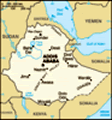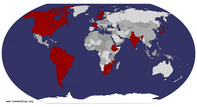Advertisement
Published: April 16th 2014
After 6 weeks in the Southern Africa region, it was an exciting prospect to be changing things up. Daniel, Phil and I were on our way to Ethiopia. Granted every country in Southern Africa was unique in several ways, but at the same time there was still a regional constant between them all. Aside from the fact that we were still in Africa, this constant was no more upon our arrival to Ethiopia.
Daniel was the catalyst for this leg of the trip as his parents live in Addis Ababa, the capital of Ethiopia, and his mother is the number-2 at the Swedish Embassy there. Graciously, Daniel and his parents invited Phil and I to stay in their home for a week and we gratefully obliged. Typically, Ethiopia wouldn’t be the luxurious stretch of one’s travels, but in our case it was. Comfortable and clean bedrooms, reliable hot water, high-speed internet, some of the finest coffee in the world (Ethiopia is known as the birth place of coffee) awaiting you in the morning and so on… such luxuries when backpacking. The other glorious bonus of being hosted here was that we needn’t think about or plan the days’ moves, as
Daniel’s parents took the liberty of doing so for us, with a perfect balance of country-side exploration, city time, and down time around the house for the six days we had in Addis.
Before sharing some of my Ethiopian excursions with you, first some observations and reflections after a more appropriate visit than the less than 24 hours I spent in Addis at the start of my Africa adventure. The people are extremely friendly and generous in this country. On several occasions, we were invited by strangers to join them for a meal or a drink. Daniel’s parents explained to us that it’s customary for Ethiopians, even if they may have very little, to share the little they do have. Addis, despite the poverty that is abound, is and feels like an extremely safe city. At more than 7,500 feet above sea level, the air in Addis has a high elevation chill in the shade, yet the sun is warm and quickly burns when exposed to it. The city ebbs and flows in a massive game of chicken involving both the pedestrians and the vehicular traffic, an incredibly chaotic motion of weaving cars, trucks, donkeys and people that somehow
works. A diesel fume permeates the air. The sounds of the city are filled with typical urban sounds but mixed with the sounds of competing churches which blare music through massive PA systems day and night. The food, though not my favorite in the world, is still a delicious, beautiful and colorful experience which revolves around a spongy flat bread called injera made from the teff grain that grows in Ethiopia’s highlands. Another element of Ethiopia’s uniqueness stems from its extraordinary history. One with emperors claimed to be direct descendants of the Queen of Sheba and King Solomon and a deep religious culture stemming from the development of the Ethiopian Orthodox Church. Of Ethiopia’s modern history, it was quite remarkably never colonized which helped in preserving its rich customs and traditions through to today. It’s also the homeland of the Rastafarian ‘way of life’ in the sense that the highly praised Ethiopian Emperor Haile Selassie who ruled in the mid-1900’s is ‘Jah,’ the second coming of Jesus. Upon learning even just a little bit of such a history, it felt like we were in some kind of holy land to me.
As previously mentioned, Daniel’s parents lead our explorations
in Ethiopia and having a car and a ‘local’ to take us around not only made things preferably thoughtless on my part, but also possible, as coordinating such excursions on our own would have been logistically difficult. Our first day trip was within Addis, to a small mountain called Entoto, where the city was first founded. Today, Entoto offers hazy views of Addis below, some colorfully painted churches (as seems to be the style), and some museums. One of the museums we visited was an old palace, modest to say the least, made of clay and straw walls and formerly used by Emperor Menelik II in the 1800’s. Rather different than your European style castle or palace. In addition to a museum visit housing some garb and other relics of recent royalty, we were invited by a family to join them in celebration of something (I do not know what). Since it’s rude to decline, we accepted their invitation, and joined the family for some bread while politefully passing on the homemade tea and beer (which Daniel’s parents didn’t believe our stomachs to be ready for). On our drive down Entoto, we observed the heartbreaking though informative sight of women
of varying ages hauling massive loads of Eucalyptus twigs down the mountain. Some of these women must be decades younger than they appear, weathered by a hard life as they strap loads up to 40 kilos onto their hunched over backs and plod down the steep mountain in slippers. I feel it in my knees whenever I hike downhill, even with a light pack on my back, so I can only imagine what this must be doing to their bodies, which is of course all in the name of survival as each load is hardly worth anything.
For our next day trip we would again be driving up a mountain. An hour outside of Addis, we reached the Menagesha mountain and forest for some country-side sightseeing and wildlife viewing. The drive up alone was spectacular. Teff farms set the landscape to a earth-toned mix of brown, gold and green plots. When we got to the top of the mountain, our first task was fika, in true Swedish fashion, followed by a short hike on foot further up Menagesha for views of the surrounding open highland farmlands. At the top of the mountain, deforestation misleads one to the actual forest
habitat, but a little further back down the mountain, there is untouched forest and it is spectacular. It’s one of those forests that looks ancient, like you could be walking back in time. Towering trees, every bit of which are covered with mosses and lichens. I don’t know the exact micro-climate but the forest here was dense, lush and leafy, almost like a rainforest. Though the forest alone was a great experience, we were hoping to find Colobus monkeys, a quite large monkey species with black and white hair patterns, a very long bushy tail. We were in luck as we found two separate groups of Colobus, each numbering four or five. Though they were some 20 meters up a tree, we were eye to eye with the first batch of monkeys as we were far up a hillside not too far away, and they stared at us inquisitively just as we did to them. In addition to the Colobus, we were also lucky enough to see one of Ethiopia’s endemics, the Menelik bush buck, as a pair pranced across the road in front of us just before we spotted the Colobus above us.
Our third day trip was
a grander mission than the previous, but such aspirations are called for when your entourage of economists in Ethiopia grows even larger. On April 8
th, Dante and Frida, two more of my classmates from Sweden who had been doing field work in Malawi, joined us in Addis. We were now 5 out of the approximately 20 in our class, all in Addis… what were we all doing here!? To celebrate this mini class reunion, Daniel’s father took us a fewer hours deeper into the countryside to see arguably Africa’s largest canyon (some sources say it’s the Fish River Canyon in Namibia), the Blue Nile Gorge. The farms again laid out a spectacular landscape for the 2+ hour drive across rolling hills, until quite abruptly the farms ended and we were driving along the edge of a huge gash in the earth (one that completely dwarfs Blyde for example). At the base of the canyon runs the Jamma River, a tributary to the Blue Nile River. Here we took a short hike along the rim of the canyon, lined with cacti and flowering shrubs, all the while soaking up the expansive canyon. Though this place is no secret, and I have
no idea if perhaps it’s crowded at other moments in time, it was especially nice to experience it nearly all to ourselves, unlike many other commercialized natural wonders. After a picnic lunch, we hopped back in the car for phase 2 of the days agenda – finding another of Ethiopia’s endemic species, the Gelada Baboon. Such baboons have two distinct features, long lion’s-mane-like hair and a red patch across their chest (rather than the red patch on the butt on typical baboons). Daniel’s father had a spot in mind of where to find them, an hour down a small gravel road to a village in the middle of nowhere, but of course there’s never a guarantee. Luckily, the baboons were awaiting our arrival. A pack of at least 30 baboons slowly moseyed and munched their way through the tall grass, a large part of the diet for this species, while we watched from a short distance away. They were peaceful and not at all bothered with our presence, letting us observe them and take photos for as long as we pleased.
Aside from these day trips, the rest of our time was more or less spent relaxing in Addis
with a mix of the following - slow days at Daniel’s parents’ home, Swedish diplomatic house parties, dominating my classmates in bowling (high score of 134! 😉, shopping in the Addis street markets and lastly, a cultureless poolside day at the Sheraton. We did however cram in one last incredible stop just before making our way to the airport on the last day – a visit to the National Museum to see Lucy, which at the time of discovery, were the oldest hominid fossils ever found, some 3.2 million years old. The museum also has some fossils dating back nearly 10 million years to earlier believed species of the human evolutino. Pretty remarkable. This exhibit, like those in natural history museums which go through the history of the universe, remind me how small and insignificant we are, which I love.
So, that wraps up Africa. A huge, huge, huge thanks to Daniel and his parents for the most recent luxurious and homely stint of the trip. It was an awesome seven weeks. Though my academic aspirations were extremely overzealous, I did and saw everything I had hoped otherwise. Now I part ways from my classmates for the
remaining two weeks of this trip. I’m hopping the Indian Ocean to find Adina in India!
Advertisement
Tot: 0.168s; Tpl: 0.02s; cc: 20; qc: 75; dbt: 0.0908s; 1; m:domysql w:travelblog (10.17.0.13); sld: 1;
; mem: 1.3mb






















Dancing Dave
David Hooper
I salute you Ethiopia
I reckon Ethiopia is the Jewel of Africa...fantastic you could share it with friends to get a taste of that fantastic country. Pretty cool that you had diplomatic digs too!